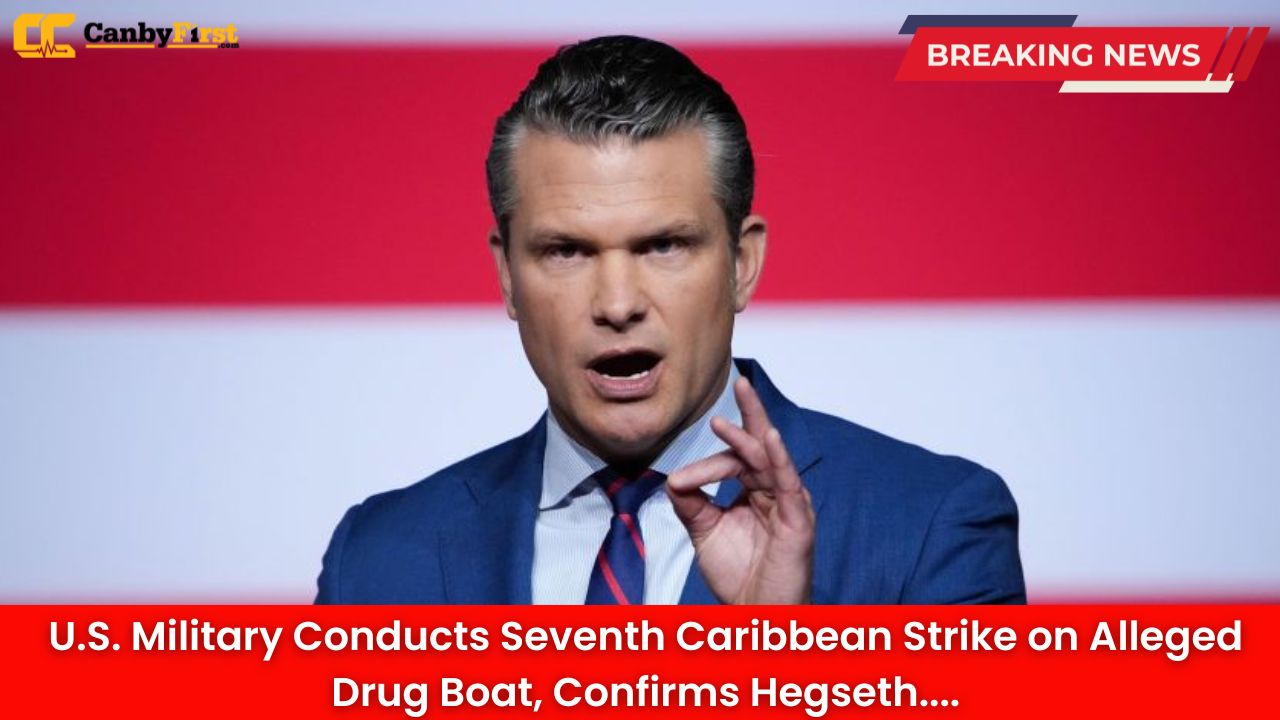The U.S. military has carried out its seventh targeted strike this month against a suspected drug-smuggling vessel in the Caribbean Sea, according to statements made Monday by Defense Secretary Pete Hegseth. The latest strike is part of an expanding maritime campaign intended to curb the flow of illicit narcotics destined for U.S. shores and Central American routes.
Hegseth confirmed that U.S. Navy and Air Force assets collaborated with law enforcement officials to identify, intercept, and destroy the vessel, which was allegedly transporting multiple tons of cocaine and other narcotics. No U.S. personnel were injured in the operation.
“This was another successful interdiction. Our message is clear: the Caribbean will not serve as a safe corridor for drug traffickers,” Hegseth declared during a briefing at the Pentagon.
Also Read
Details of the Strike
According to defense sources, the operation took place late Sunday evening near international waters south of Puerto Rico, a region increasingly monitored by U.S. surveillance aircraft and naval patrols. The vessel, believed to be a “narco-speedboat” operated by Colombian and Venezuelan traffickers, reportedly ignored repeated calls to surrender before being neutralized.
Intelligence gathered from prior interceptions led to the coordinated strike, which involved both air-to-sea munitions and support from a U.S. Coast Guard cutter operating nearby. Officials reported that debris from the explosion was recovered and identified as containing traces of controlled substances.
Following the strike, three crew members were taken into custody by allied regional forces and are being interrogated for links to transnational criminal networks.
Part of a Broader Regional Initiative
The strike is part of an expanded Caribbean Interdiction Task Force operation launched earlier this year under President Trump’s national security directive on border protection and transnational crime. The initiative aims to dismantle major trafficking rings operating throughout Caribbean maritime corridors, long used as transit routes for narcotics headed to North America and Europe.
U.S. military planners say that the Caribbean narcotics flow — particularly from South American ports through the Windward Passage — has surged since early 2024. The Pentagon’s current efforts combine military enforcement with diplomatic coordination among Caribbean nations, including the Dominican Republic, Jamaica, and the Bahamas.
Hegseth emphasized that the United States would continue to deploy intelligence, drones, and naval resources in the region “until trafficking operations are permanently disrupted.”
Law Enforcement and International Cooperation
The Drug Enforcement Administration (DEA) and the U.S. Coast Guard are working closely with the Department of Defense on intelligence sharing and coordination. The Joint Interagency Task Force South, headquartered in Key West, Florida, has identified increased collaboration among cartels in coastal South America.
Regional allies, including Colombia and Panama, have provided intelligence that has helped pinpoint “go-fast” boats and submersible vessels used to evade radar detection. Many of these smugglers operate under the protection of loosely organized militias or corrupt fishing syndicates.
A senior Coast Guard official stated, “Each strike weakens a link in a larger criminal chain. We are focusing not only on interdictions but also on dismantling entire trafficking routes.”
Regional Reaction and Concerns
Caribbean governments have expressed cautious support for the U.S. campaign, acknowledging the severe impact of narcotics trafficking on local economies and governance. However, some human rights groups have raised concerns about the increasing use of force in international waters without publicized judicial oversight.
In response, Pentagon officials assert that all actions are conducted in compliance with international law and in coordination with regional partners. “These are criminal operations, not legitimate trade vessels,” Hegseth said. “Every engagement follows verified intelligence and lawful engagement procedures.”
Impact on Drug Trafficking Networks
Analysts suggest that this seventh strike signals a turning point in maritime anti-drug operations. Satellite tracking and real-time data sharing have made the region’s smugglers more vulnerable than ever.
Over the past two months, U.S. forces have intercepted or destroyed over 25 tons of narcotics, valued at more than $900 million on the international black market. Officials believe that disrupting ocean-based trafficking routes could significantly reduce drug-related crime within the continental U.S. over the next year.
Still, experts warn that cartels may adapt by using more advanced submersible technologies or rerouting shipments through Central America’s Pacific coasts.
Next Steps for U.S. Strategy
Hegseth indicated that plans are under discussion for joint training exercises with Caribbean naval units in early November, designed to improve maritime coordination and combat readiness. The Defense Department also plans to increase the presence of unmanned surveillance systems to monitor suspected trafficking corridors 24/7.
According to military analysts, the success of these strikes could pave the way for a permanent U.S. maritime monitoring mission across the region, similar to existing counterterrorism patrols in the Middle East and Africa.
Hegseth concluded Monday’s briefing with a firm statement: “The United States will not allow our southern waters to become a highway for criminal enterprises. Every illegal shipment we intercept makes America and our partners safer.”
FAQ
What was targeted in this latest strike?
A suspected Colombian-Venezuelan narcotics vessel operating in Caribbean waters near Puerto Rico.
How many such strikes have occurred so far?
This operation marks the seventh U.S. military strike against alleged drug boats in October alone.
Which agencies were involved?
The U.S. Navy, Air Force, Coast Guard, and the Drug Enforcement Administration (DEA) jointly coordinated the mission.
Are these operations legal under international law?
Yes, the Pentagon asserts that all missions follow international maritime law and are carried out in coordination with regional allies.
What’s next for U.S. anti-trafficking operations?
Expanded surveillance, joint naval training with Caribbean nations, and further enforcement operations are planned in the coming months.












